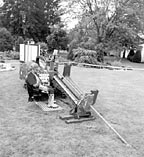
"The HDD market is growing tremendously," notes David Abbott from the San Diego office of Jason Consultants International Inc. "There are many more manufacturers and there are many more contractors. This means the market is becoming more competitive and therefore prices are dropping. I guess that's a good thing for the world but not necessarily a good thing for some of the individuals."
Competition also spurs technological advances. "It leads to innovation," Abbott explains. "The industry will keep stretching the envelope. In the case of horizontal directional drilling, the capital expenditure is not terribly high, and the rigs are fairly simple to use so everyone is looking for an advantage."
Telecommunications installations represent the largest slice of the HDD-use pie -- and will continue to present solid opportunities for the foreseeable future. Says Abbott: "The fiber optics market is extremely active and it should continue that way for quite some time. Telephone, television and the Internet represent a huge market. A lot of effort is going into trying to increase the speed and reliability of all the underground cables."
Bill Krueger concurs. Krueger is vice president of sales and marketing for Mears/HDD Inc., Rosebush, Mich. He says, "Almost half of the directional drilling that's being done is in the telecommunications arena. Over the past three to four years a tremendous amount of effort has been devoted to the cross-country networks. Over the next few years most of those will probably be built out and the emphasis will switch to "the last mile" -- starting with the major cities and then on down to the tier two and tier three cities and towns." Krueger sees this window of opportunity to be maybe five years.
Plentiful Opportunities
While telecommunications presents terrific opportunities, forward-thinking contractors are keeping their horizons as broad as possible so they'll have the ability to adapt to changing market conditions and be in a position to maximize the openings that will continually evolve. Other markets to look at are water and sewer work, electric cable, environmental remediation and oil and gas projects -- no small amount of which is being spurred by municipalities."There's potential for growth in all markets," Krueger confirms. "In 1999, 30 percent of all the new construction -- telecommunications, water, electric, sewer, gas, utilities, environmental remediation and even larger transmission pipelines -- was done using directional drilling. By the end of this year, it's projected to be 35 percent, and then by the end of 2005, it's expected to be nearly 50 percent."
The driving forces: Abbott points out that HDD is increasingly cost-effective, quick and non-intrusive. And Krueger stresses the environmental regulations and ordinances prohibiting open cuts.
While several forces are converging to create excellent opportunities for contractors doing HDD, they are held somewhat in check by the ubiquitous lack-of-skilled-labor factor here in the United States -- a decidedly frustrating situation. But you can always look to international markets. "The growth in HDD is worldwide," Abbott tells us. Many people point to South America as an example. "In Brazil, for instance," Abbott offers, "The market there is becoming nearly as developed as it is here -- lots of machines, lots of contractors, low prices and everyone's pulling in cable like crazy."
Along similar lines regarding foreign markets, Krueger relates, "They're behind us as far as percentage of work (vs. open trench) but they are growing fast."
Looking Ahead
In the near term, what types of advancements should we expect? Answers Abbott: "The manufacturers are working on ways to have HDD used in harder materials. The little machines can have difficulty in the displacement of granular materials, particularly gravels and cobbles. And even hard clays can present a problem so the manufacturers are looking at ways of dealing with that."There also are efforts underway to steer the drill in a more accurate way -- for example with sewers where plus or minus three inches can make a difference between getting ponds in there or not. And, of course, the manufacturers are always trying to get longer distances out of the rigs as well."
But the industry can't sit back and wait for the manufacturers and suppliers to come up with all the ideas for improvements. Be proud of the fact that Abbott says, "A lot of the new technology is contractor-driven. A contractor will go to a manufacturer and say, 'I've got this rig; can I go through this?' or 'Can I do this?' and the manufacturer will say, 'Hmm, let's go try it.' It's the contractors who are in touch with the marketplace."
Looking even further ahead -- Krueger predicts HDD growth will eventually level out at somewhere upwards of 60 percent of the market. His explanation: "In most cases, open trenching is more cost-effective so where it can be used it will be used."
If you are into horizontal directional drilling, just make sure you're in position to tap into an appropriate amount of that 60 percent.
Report Abusive Comment